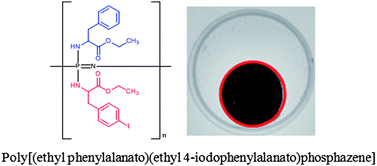Iodine-containing radio-opaque polyphosphazenes†
Abstract
The first poly(organophosphazenes) with iodinated side

* Corresponding authors
a
Department of Chemistry, The Pennsylvania State University, 104 Chemistry Research Building, University Park, PA, USA
E-mail:
hra@chem.psu.edu
b Department of Orthopedic Surgery, University of Connecticut Health Center, Farmington, CT, USA
c Department of Chemical, Materials and Biomolecular Engineering, University of Connecticut, Storrs, CT, USA
The first poly(organophosphazenes) with iodinated side

 Please wait while we load your content...
Something went wrong. Try again?
Please wait while we load your content...
Something went wrong. Try again?
M. D. Hindenlang, A. A. Soudakov, G. H. Imler, C. T. Laurencin, L. S. Nair and H. R. Allcock, Polym. Chem., 2010, 1, 1467 DOI: 10.1039/C0PY00126K
To request permission to reproduce material from this article, please go to the Copyright Clearance Center request page.
If you are an author contributing to an RSC publication, you do not need to request permission provided correct acknowledgement is given.
If you are the author of this article, you do not need to request permission to reproduce figures and diagrams provided correct acknowledgement is given. If you want to reproduce the whole article in a third-party publication (excluding your thesis/dissertation for which permission is not required) please go to the Copyright Clearance Center request page.
Read more about how to correctly acknowledge RSC content.
 Fetching data from CrossRef.
Fetching data from CrossRef.
This may take some time to load.
Loading related content
